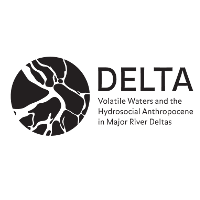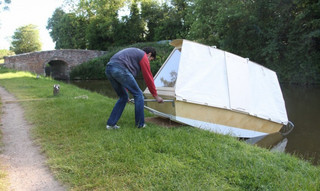Auf dem SIEF2017 Kongress in Göttingen, der um das Thema Ways of Dwelling: Crisis - Craft - Creativity kreist, werden vier Mitglieder des DELTA-Teams Papers präsentieren zudem sind einige von ihnen an einem Panel mit dem Titel Amphibious Dwelling: Exploring Life between Wet and Dry beteiligt.
- Benoit wird ein Paper unter dem Titel The Horseshoe Circles: living with floods in the embanked landscapes of the Irrawaddy (Ayeyarwady) Delta, Myanmar präsentieren
- Franz hat seine Präsentation "Never say die" - notes on a stubborn hamlet in an Arctic river delta genannt
- Nora wird ein Paper präsentieren, das zusammen mit Julien Blanc (Musée de l'Homme, Paris) verfasst wurde und den Titel Dwelling strategies within an urbanizing Brazilian floodplain: new coping strategies for novel uncertainties trägt
- Sandros Präsentation läuft unter dem Titel Volatile Powers: Place- and Force-Making in the Tana Delta and Beyond
Die Abstracts zu den Vorträgen finden Sie weiter unten. Schauen Sie gerne vorbei und sprechen Sie uns an, falls Sie zum Kongress kommen (Anmeldung beginnt am 18.12.16, Frühbucherrabatt bekommen Sie bis zum 22.01.17). Alle, die an Volatilität, Wasser und Deltas interessiert sind, könnten auch das Panel Dwelling in an Evanescent Landscape: People's Strategies to deal with Chronical Uncertainty bei dem Nora einen Vortrag gibt und/oder den Workshop The Changing Time and Rhythms of Water spannend finden.
Abstracts
Sandro Simon
Volatile Powers: Place- and Force-Making in the Tana Delta and Beyond
Short Abstract
The Tana Delta has a longstanding history of ecological change, territorial re-organization and socio-political tensions. This papers seeks to show how this relates to the delta's own high socio-physical volatility and the multi-stranded and -directional flows of power in and beyond the delta.
Long Abstract
The nesting of power in a delta (e.g. dams, irrigation schemes) is both a spatial and a temporal phenomena. Places of power are continuously becoming more of a place and less of a place. Thereby, the flows that help to constitute them, for instance water, knowledge or money, are not uni-directional: A dam or irrigation project is neither 'put over' a place nor the direct result of upstream to downstream- or global to local-flow, because both 'place-making' and 'force-making' are caught up in differently scaled and interrelated phenomena at the same time (cf. Tsing 2002).
In the case of the 16,800 ha Tana Delta Irrigation Project, funded in 1987 by the Japanese development cooperation, international and national actors with diverging political and economic agendas tried to establish a project that aimed at boosting rice production and transforming local work practices from farming and herding to wage labor. However, the project was characterized by non-functionality (e.g. in terms of output, hydrology or local food security and public health) and was largely abandoned after the destruction of its main embankment by El Niño floods in 1998.
Hence, the project was on the one hand indeed a strong driver of social and physical change but, on the other hand, largely dissolved because of its inability to 'dance along' to the volatile and interrelated socio-physical flows. Thus, this paper will try to trace how its fixity, both materially and conceptually, prevented it from establishing a spatially and temporally persistent, and simultaneously emergent, place of power.
Nora Horisberger and Julien Blanc
Dwelling strategies within an urbanizing Brazilian floodplain: new coping strategies for novel uncertainties
Short Abstract
We’ll discuss how "traditional" dwelling strategies and related knowledge relate to new status and roles locally assigned to "nature" within a Brazilian floodplain landscape. Our focus is on a settlement located in Northeast Brazil undergoing strong urbanization dynamics since the 1980s.
Long Abstract
Our presentation explores the ways floodplain dwellers re-negotiate both the role and the status of the landscape they inhabit, in a context of accelerating urbanization. For decades or more, life in Aranha, a settlement located in Northeast Brazil, has been relying on multiple livelihoods (fishing, agriculture, livestock farming, extractivism) that are complementary in space and time. Such a diversity of ways of dwelling enables the people of Aranha to adjust to strong fluctuations of the environment. Indeed, Aranha's environment undergoes complex flooding cycles, due to the combined influence of rain and tides, giving the landscape an ambiguous character between terrestrial and aquatic.
As we will argue, the ways people of Aranha engage with "nature" nowadays must, however, be analysed in a larger frame, due mainly to the accelerated urbanization process taking place in the region. We will show how the question of "nature" is renewed, renegotiated and re-inserted in the context of these changes. In particular, the landscape is revalued throughout new dimensions such as its aesthetic quality, its contribution to wellbeing, its economic value or its potential regarding conservation. "Dwelling", although remaining central in Aranha, thus became one of the multiple ways of relating to this landscape. But how do these various possibilities of engaging with "nature" interrelate locally? How do dwelling strategies and related knowledge evolve within this frame? How is coping with uncertainty reframed in this context? These are the main questions we will address here.
Franz Krause
"Never say die" - notes on a stubborn hamlet in an Arctic river delta
Short Abstract
This presentation relates narratives from Aklavik, NWT (Canada), to the grand narrative of progress and modernity, and elaborates some inherent frictions.
Long Abstract
Aklavik is a settlement of around 600 inhabitants in the centre on the Canadian Mackenzie Delta. Its multi-ethnic population is mostly comprised of people belonging to the Inuvialuit and Gwich'in First Nations. These and other groups congregated at Aklavik in the process of the fur trade, which had its peak in the Mackenzie Delta during the early 20th century, when Aklavik turned into a regional hub for services and administration.
After a series of floods, and the realization that expanding Aklavik into the muddy delta would be rather complicated, the government decided to relocate the hamlet and its inhabitants to higher ground at the edge of the delta, where they created a purpose built town. While most services and many people moved, some preferred to stay in Aklavik, preferring the proximity of trap lines, fish camp sites and a small community to the permanent roads, municipal infrastructure and urban appeal of the new town. Some of the remaining inhabitants, not without a sense of humour, coined the hamlet's new slogan: 'never say die!'
This presentation will outline some of the idiosyncrasies of life in Aklavik, which people often formulate in opposition to the more modern and progressive ways of town life. It will trace the role that the amphibious delta environment plays in these narratives of distinctiveness, and point to some possible relations between this amphibiousness and the hamlet's multi-ethnic setup.
Benoit Ivars
The Horseshoe Circles: living with floods in the embanked landscapes of the Irrawaddy (Ayeyarwady) Delta, Myanmar
Short Abstract
This paper discusses the land-and-water dynamics surrounding the construction of horseshoe embankments in the Irrawaddy river delta. It will shed light on the interconnectedness and constant negotiations between the lands and waters in the building of the amphibious space of deltas.
Long Abstract
Recent years have seen the rise of several works documenting open approaches to flood management, whose focus is to provide openings for river water and sediment dynamics across floodplains. These perspectives have been described as contrasting with the dominant paradigm of closing-off initiatives that epitomize images of separation between land and water, rivers and fields, including polders, embankments and large-scale control structures. This paper attempts to follow a more balanced approach by focusing on the historical development of horseshoe, or U-shaped, embankments that were constructed in the Upper Irrawaddy Delta during the British colonial rule (1824-1948). Such embankments surrounding only the upstream parts of delta islands allow water to flow and mimic ordinary drainage conditions. They not only offer a glimpse into some of the nuances between closed and open approaches to water management, but a deeper historical gaze into the contested transformation of wet-and-dry places. The article's intention is twofold. First, it seeks to expand our repertoire of how water and land are merged and separated by human activities, and how those activities are in turn shaped by land-water dynamics. Second, it seeks to ignite a sense of place that is neither overly wet nor dry, open nor closed, and how these conditions are profoundly mixed and evenly experienced among delta inhabitants. In so doing, it raises questions of openness for whom, and closeness of what, emphasizing the need to better grasp interactions between infrastructural forms, watery relationships and topographical variations for approaching delta life, between land and water.


